Positive Health Online
Your Country

Reflexology - A Second Look
listed in reflexology, originally published in issue 13 - July 1996
Definition
Reflexology is concerned with the study of reflexes in the feet, which correspond to all parts of the body. It is a method of treatment which exploits the presence of these pedal reflex points, using a specific pressure technique.
History
Reflexology is not a new method of treatment. It goes back at least 5000 years when some form of pressure therapy was practised in China, India and Egypt; a wall painting, found in the tomb of the Egyptian physician Ankhmahor at Saqqara (about 2330 BC), shows such treatment being administered.
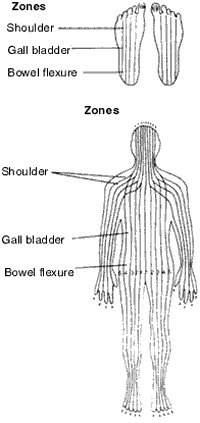
Diagram 1 – Zones
The story of modern foot reflexology started in America at the beginning of this century when Dr William Fitzgerald, an ear, nose and throat specialist, noticed that his patients experienced different levels of pain during their operations. He observed that the patients who experienced less pain were those who during the operation were squeezing their hands together tightly. This led him, together with some of his colleagues, to investigate and chart the pressure points which led to a reduction in pain. Eunice Ingham, a physiotherapist working with the team, explored the idea further. She argued that if hard pressure stops the sensation of pain being relayed to the brain, reduced pressure might stimulate the nerve impulses and achieve therapeutic effects beyond pain reduction. Whilst working on the hands she found that reflex points could also be found on the feet and that working on them there was more effective.
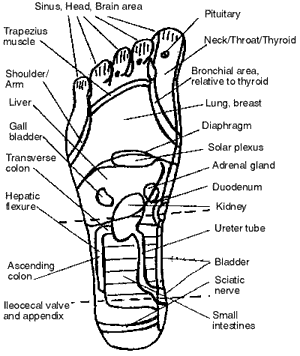
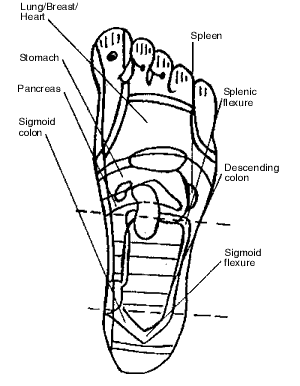
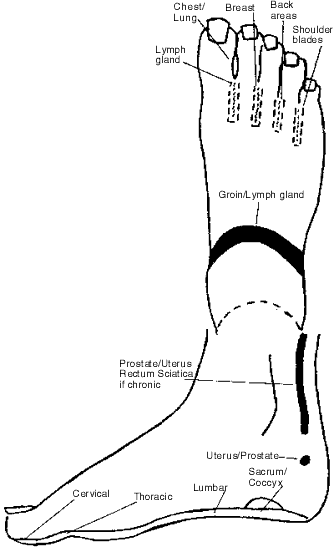
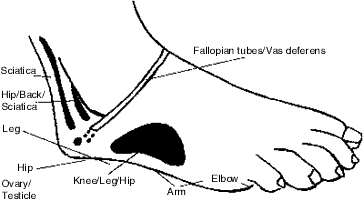
Diagram 2 Energy Pathways
Development
In charting their findings these pioneers of foot reflexology noticed that the relationships between points pressed on the feet and the parts affected occurred along definite pathways. They drew up a diagrammatic chart of these pathways and called them 'zones' (diagram 1). Reflexology, the treatment based on these zones, has also been know as 'foot zone therapy'. It has since occurred to some reflexologists, notably Inge Dougans, that the zones discovered by Dr Fitzgerald and Eunice Ingham correspond rather neatly with the meridian theory of acupuncture. She argued that acupuncture and reflexology share the same concept of energy channels which happened to have been given different names; namely 'meridians' in acupuncture and 'zones' in reflexology. She pointed out, though, that the energy flows in one continuum and that dividing that continuum into different meridians is purely a measure to facilitate discourse. Regardless of what the energy pathways are called, empirical science has demonstrated that, though not visible, they exist and that working on the reflex points can improve health, prevent or even cure disease.
Theory
The theory underlying reflexology practice is that pressure on reflex points stimulates the energy flow along a pathway (meridian, zone), clearing congestion and balancing it throughout. Pressure applied to any part of the pathway affects the entire pathway. Working on all reflex points in the feet returns the body to homoeostasis, defined as the tendency towards a relatively stable equilibrium between interdependent elements, especially as maintained by physiological processes. Once in this state the body's own immune system will be able to overcome whatever is troubling it.
Practice
The practitioner gently exerts firm pressure on the reflex points in a systematic way, in order not to miss any, by making small, creeping movements, caterpillar fashion, with a thumb or finger along each foot. This stimulates and sends nerve impulses along the energy pathways to the various parts of the body to which they are connected (diagram 2). The impulses clear or reduce the congestion in the energy channels, thereby revitalising the energy flow and promoting homoeostasis. Congestion or symptoms of ill health in the body are revealed as tenderness or pain over the reflex points in the feet which usually subsides on application of gentle pressure over the points. Sometimes grit-like structures (calcium deposits) can be felt which cause momentary acute pain; the treatment easily breaks them down, and once broken down they are excreted in the normal way. Care needs to be taken not to go beyond the patient's pain threshold, because reflexology is effective through reducing tension and inducing relaxation; pain creates tension, and going beyond the pain threshold is counter-productive as well as distressful. There is, nevertheless, a level of pain which patients often call a 'healthy pain', because they are aware that this pain is a precursor to the relief of their symptoms and ultimately better health.
Congestion in the energy channels is often due to stress, be it mental or spiritual, or physical factors, such as pollution and food additives, which are unavoidable these days. Prolonged stress, tension or fear can lead to disease and disorders of various kinds. Stress triggers the body's fight or flight reaction: the adrenal glands then start producing additional adrenalin in order to cope with the perceived threat to survival. Regardless of whether the stress is life threatening or simply that of present day life-style, the body continues to release extra adrenalin for as long as stress is a factor in a patient's life. (We are talking here about stress beyond a person's ability to cope and not the kind of stress which enables achievement, as experienced, for example, by sportsmen and women or by persons in other fields of healthy competition.) The continuing presence of extra adrenalin sets in motion a spiral of cause and effect leading to disease (see diagram 3). By promoting homoeostasis reflexology addresses the problems caused by stress: one could say that it acts as a catalyst to healing in that it stimulates the body's own self-regulatory and healing capability.
The duration of reflexology treatment depends on the degree of congestion in the tissues and malfunctioning of the body. People often put up with symptoms for years before deciding to seek help. Chronic conditions take longer to improve than a recent ailment. Healing is a process – it takes time; on average a treatment course of six sessions, each lasting about an hour, will show results.
Reactions
Virtually everyone can benefit from reflexology. It is a safe treatment with no side effects, but reactions to the treatment, often called healing crises, are possible, though not everyone will experience one. A healing crisis confirms that the body now has the strength to deal with its problems. As the treatment activates the body's healing powers the accumulated waste products and toxins, which may have lain dormant in the body for some time, are released into the bloodstream and excreted. A healing crisis is therefore nothing more than a cleansing process. The symptoms of a healing crisis vary according to the nature of the toxins released: those affecting the respiratory system could result in common cold or flu symptoms; those affecting the digestive tract in diarrhoea, flatulence, vomiting or nausea; there could be skin rashes, increased urination with darker and stronger smelling urine owing to the toxins being washed out, and arthritic pains might flare up. However, these symptoms are usually short-lived, about one or two days, and are generally followed by a feeling of increased energy and well-being. Patients having been fore-warned are prepared to endure a healing crisis in the knowledge that it is a step towards recovery.
Occasionally there is no response to the treatment, even after several sessions. The underlying stress may be persistent and of such magnitude that the physical manifestations of it persist. In such cases counselling skills might enable reflexologists to help their patients to formulate their problems, for a clear statement of the nature of the problem often suggests a solution to it.
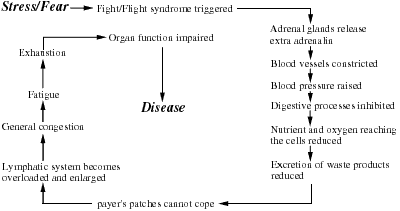
Diagram 3 Energy Pathways
Basic rules
Reflexologists follow a set of guide lines which include:
- explaining to the patient what reflexology is and how it works;
- reassuring the patient throughout the course of treatment;
- encouraging patients to open up and to relax;
- suggesting methods of self-help;
- advising patients to seek medical help if symptoms merit it.
It is important that reflexologists do not venture into areas beyond their expertise; they therefore do not diagnose, nor prescribe nor promise a cure. Reflexology works without a diagnosis if administered correctly.
Cautions
It was mentioned earlier that reflexology is safe and that anybody can benefit from it. There are, nevertheless, a few conditions where reflexologists practise caution and often postpone treatment. The most obvious one is damage to the feet, i.e. cuts and bruises, boils, damaged tendons, recent fractures. As reflexology improves the blood circulation treatment is also deferred immediately after an operation, until a doctor has pronounced the wound as healed, owing to the danger of bleeding from the wound. Patients on heavy medication are treated with lighter pressure, because improved blood circulation could result in quicker elimination of the drugs, thus possibly de-stabilising the condition for which they have been prescribed. In such cases (and generally when a patient is under treatment from his/her GP) reflexologists would seek permission from the patient's GP to give reflexology treatment. Similarly, patients having fever are not treated until fever-free, as their bodies are already coping with an influx of toxins and it is unwise to burden the body even further by releasing more toxins into the bloodstream.
Conclusion
Reflexology embraces the holistic approach to healing, considering the person as a whole, in the knowledge that all aspects of the body – physical, mental and spiritual – are interdependent and interact with one another. It is a form of treatment particularly suitable for stress-related diseases, especially in cases where there seems to be no clinical evidence of disease. Experience has shown that patients have been helped by reflexology after orthodox medicine had proved ineffective. It is, therefore, a pity that it and other methods of complementary medicine are not more freely available on the NHS.
References
1) Ingham, E.D. (1938, revised 1984) Stories the Feet Can Tell/Stories the Feet Have Told Thru Reflexology, published by Ingham Publishing, Inc., P.O. Box 12642, St Petersburg, Florida 33733-2642, U.S.A.
2) Hague, P. (1990) Synthesis, published by: CIC Publishing, 119 Mill Road, Cambridge.
3) Kunz, K and B (1982) The Complete Guide to Foot Reflexology, published in Great Britain by: Thorsons Publishers Ltd, London.
4) Gillanders, A. (1987) Reflexology – The Ancient Answer to Modern Ailments, published by Jenny Lee Publishing Services, Bishop's Stortford, Herts.
5) Dougans, I. with Ellis, S. (1991) Reflexology – Foot Massage for Total Health; published in Great Britain by: Element Books Ltd, Longmead, Shaftesbury.
6) Hall, N.M. (1986) Reflexology – A Patient's Guide, published by: Thorsons Publishers Ltd, London.
7) Stormer, C. (1992) Reflexology, published by: Thomson Litho Ltd, East Kilbridge, for the educational publishing division of Hodder and Stoughton Ltd, Mill Road, Dunton Green, Sevenoaks, Kent.
Comments:
-
No Article Comments available